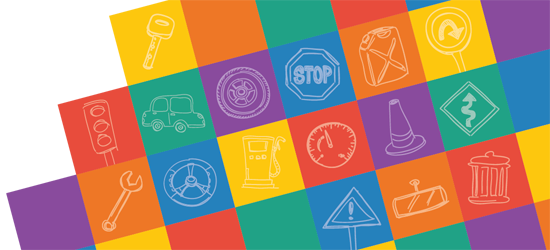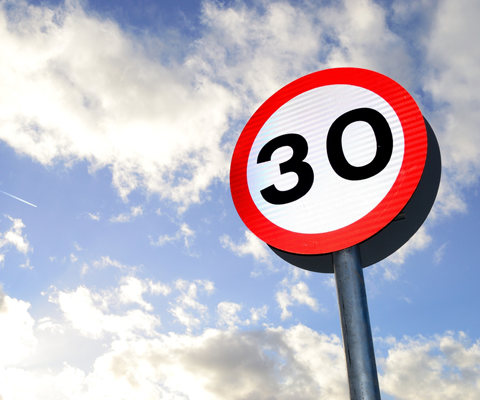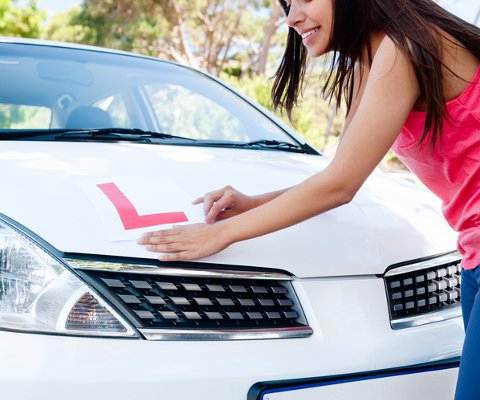
Theory test revision guide
You may have heard from your friends or parents that the driving theory test is just a box to tick.
"It's just common sense!" they cry. "Piece of cake, mate."
And hey, some of the questions ARE common sense. Common sense is a very important part of driving. But as well as common sense, there are hundreds of rules to learn that will help you as you learn to drive, help you pass your practical driving test and help you stay safe (and fine-free) for the rest of your driving life.
It's not easy. There are 1,000 questions you could get asked and some of them are about contraflow systems. Don't know what that is? Time to get revising.
-
Get the book
A book? What, one of those flappy things with words inside? Yes, my friend - get the book. The DVSA theory test book.
You may prefer an app but that's not an INSTEAD; it's an AS WELL. A physical book works because your brain is going to retain memories of flipping the pages, looking at the pictures and finding the answers in the back.
It's a chunky book but it's everything you need to know about the rules of the road. Which are kind of important if you don't want to crash or at the very least get honked a lot. Work your way through it and by the end you'll be prepared to do some practice and then take the test.
-
Get an app
There you go: digital. I would advise you to get the official DVSA theory test app because it's legit and has hazard perception practice tests in it. The free apps aren't worth the pixels they're coded on, frankly.
Use the app to practise by yourself, wherever you are and whenever you have the time. Go through the guides and test yourself on the multiple choice questions and hazard perception.
-
Practise your hazard perception
The hazard perception part of the test often trips people up because they haven't done their research and don't know what to expect.
There aren't that many places to practise hazard perception as it actually appears in the test so it's worth getting the DVSA theory test discs or using the DVSA theory test app I mentioned earlier. You can also use Drive iQ, which has loads of hazard perception test clips - worked for me!
-
Talk about the questions with your driving instructor
Hey, they're the expert! They're also full of funny ways to remember things, and every conversation you have about your theory test will help to cement bits of knowledge in your brain.
Talking about the theory behind what you're doing is the best way to understand the point of all this. It's not just something to get out of the way so you can get to the 'real' test. You need to not only know the answers but the actual practical meaning of the answers, to help you be a good driver.
Ask your instructor to shoot random questions at you while you're driving. It's great practice for developing your ability to concentrate on the road despite distractions and it'll give your brain a trial run of spitting out the right answer under pressure.
-
Ask someone to test you
Once you've been through the book and done a bit of practice with the app, ask someone friendly to test you from the back of the book. It will be hilarious and annoying, which is good - you'll remember things during your test that will jog your memory.
Like that time your mum thought having unbalanced wheels would make the car go in circles. Oh, Mum.
Over the week before your theory test, get your friendly partner to test you every night if possible, making sure to cover questions from every section - not just the ones you like!
You want to get to a point where you know them so well that your brain won't be tripped up by nerves and the answers will be almost instinctive.
How the hazard perception test works:
You'll be shown 14 clips that last 1 minute each and you can get up to 5 points per clip according to how quickly you spot each hazard. You'll need 44 out of 75 to pass. If you don't pass this bit but you pass your theory questions, you still won't pass the theory test. Soz.
The clips will show an everyday road scene with at least one 'developing hazard' to click in each clip, which is something that would cause you to slow down or change direction, like someone approaching a pestrian crossing who might walk into the road. One of the clips has 2 developing hazards.
EXAMPLE: A car is parked at the side of the road and isn't doing anything. It wouldn't cause you to take action, so it's not a developing hazard. When you get closer, the car's right-hand indicator starts to flash and it starts to move away. You'd need to slow down, so it's now a developing hazard.
You don't lose points if you click and get it wrong but clicking too much or too fast can mean you lose all your points for that clip - try to think carefully about what you're seeing.
You get 20 minutes for the hazard perception test and there are no second chances - just like real life! Remember: it doesn't matter where you click! Just click when you spot something that would make you take action on the road.
Remember why you're doing this
I've said it before and I'll say it again: it's not a box to tick so you can race to the finish line. The theory and hazard perception tests will help you as you continue learning to drive and in your test.
The actual mechanics of driving (changing gear, accelerating, braking and steering) are the very least of it. Your ability to read the road and adapt to conditions is what will get you through the test and keep you safe in the future.












